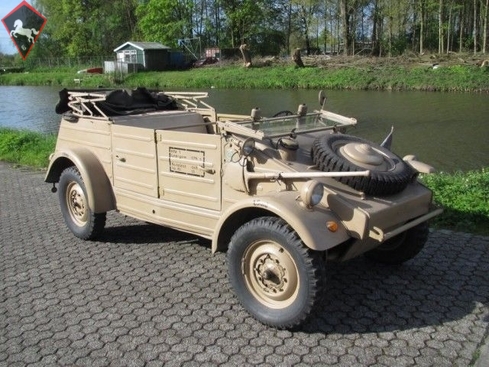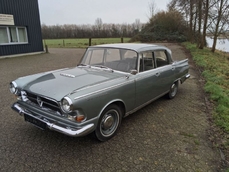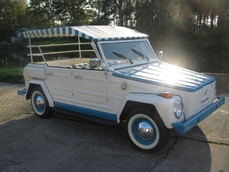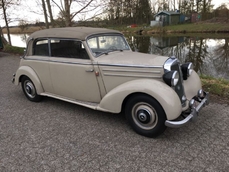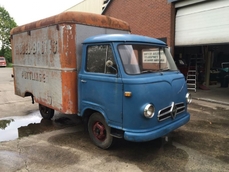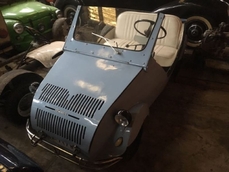Volkswagen Type 82 Kübelwagen type 82 1944
General description :
Informationen auf Deutsch
Weitere Informationen
Zylinderzahl: 4
Motorhubraum: 1.131 cc
Weitere Informationen: Roy Bolks
Informatie in het Nederlands
Opmerkingen
De Volkswagen Kubelwagen (letterlijk "Tub" -auto, die voornamelijk voor spoor-, industriele of landbouwtreinwagens gebruikt werd) was een licht militair voertuig ontworpen door Ferdinand Porsche en gebouwd door Volkswagen tijdens de Tweede Wereldoorlog voor gebruik door het Duitse leger (zowel Wehrmacht en Waffen-SS). Gebaseerd op de Volkswagen Beetle, werd het geprototypeerd als Type 62, maar werd uiteindelijk intern bekend als de Type 82. Kubelwagen is een afkorting van Kubelsitzwagen, wat "kuipstoelauto" betekent omdat alle Duitse lichte militaire voertuigen die geen deuren hadden Uitgerust met kuipstoelen om te voorkomen dat passagiers uitval. De eerste VW-testvoertuigen hadden geen deuren en waren daarom uitgerust met kuipstoelen, waardoor de naam VW Kubelsitzwagen werd verkregen die later naar Kubelwagen werd verkort. Mercedes, Opel en Tatra bouwden ook Kubel (sitz) wagens. Met zijn rollende chassis en mechanica gebouwd in Stadt des KdF-Wagens (omwisseld Wolfsburg na 1945) en zijn lichaam gebouwd door Ambi Budd Presswerke in Berlijn, was de Kubelwagen voor de Duitsers wat de Jeep en GAZ-67 waren voor de bondgenoten. Dit is een zeer zeldzame auto en origineel. Het heeft Australische papieren.
Der Volkswagen Kubelwagen war ein leichtes Militarfahrzeug, das von Ferdinand Porsche entworfen und durch Volkswagen gebaut im Zweiten Weltkrieg fur den Einsatz durch das deutsche Militar (Wehrmacht und Waffen-SS). Basierend auf dem Volkswagen Beetle, wurde es als Typ 62 prototypisiert, aber schließlich wurde es intern als Typ 82 bekannt. Kubelwagen ist eine Abkurzung von Kubelsitzwagen "Eimersitzwagen", denn alle deutschen leichten Militarfahrzeuge, die keine Turen hatten, waren Mit Schalensitzen ausgestattet, um zu verhindern, dass Passagiere herausfallen. Die ersten VW-Testfahrzeuge hatten keine Turen und wurden daher mit Schalensitzen ausgestattet und erhielten so den Namen VW Kubelsitzwagen, der spater auf Kubelwagen verkurzt wurde. Mercedes, Opel und Tatra bauten auch Kubel (sitz) Wagens. Mit dem Roll-Chassis und der Mechanik, die in der Stadt des KdF-Wagens (umbenannt in Wolfsburg nach 1945) gebaut wurde und der von den US-amerikanischen Ambi Budd Presswerken in Berlin gebauten Korper war, war der Kubelwagen fur die Deutschen fur den Jeep und GAZ-67 die Alliierten. Dies ist ein sehr seltenes Auto und Original. Es hat australische Papiere.
The Volkswagen Kubelwagen (literally, "Tub" car, previously mostly used for rail, industrial or agricultural hopper cars) was a light military vehicle designed by Ferdinand Porsche and built by Volkswagen during World War II for use by the German military (both Wehrmacht and Waffen-SS). Based heavily on the Volkswagen Beetle, it was prototyped as the Type 62, but eventually became known internally as the T...
http://home.mobile.de/POTOMAC-MOTORS#des_243515900
1944 Volkswagen Type 82 Kübelwagen type 82 is listed sold on ClassicDigest in Ettensestraat 19NL-7061 AA Terborg by Auto Dealer for €59900.
Car Facts
Car type : Car Make : Volkswagen Model : Type 82 Kübelwagen Model Version : type 82 Engine size : 0.0 Model Year : 1944 Sub type : Convertible Location : Ettensestraat 19NL-7061 AA Terborg
Sold
Seller Information
Sold
Other cars listed for sale by this dealer
About Volkswagen
The Volkswagen story is indeed an intriguing tale of innovation, resilience, and post-war revival, marked by various models that have become iconic in automotive history.The People's Car (Volkswagen): Initially envisioned by Adolf Hitler in the 1930s as a "people's car" or "Volkswagen" in German, the idea was to create an affordable and practical vehicle for the German people. This concept led to the development of the Volkswagen Beetle (or the Type 1), designed by Ferdinand Porsche.
Post-War Challenges: After World War II, Volkswagen faced significant challenges. The factory was heavily damaged, and the brand's association with the Nazi regime led to a lack of interest in the car in some regions.
British Intervention - The British Army & Ivan Hirst: The British Army took control of the factory in the immediate post-war period. Major Ivan Hirst, a British Army officer, played a crucial role in reviving Volkswagen. He recognized the potential of the Beetle and advocated for its production, convincing the British military to order several thousand cars. This decision helped jumpstart the brand's revival.
Export Success and the Beetle's Global Appeal: The Beetle gained popularity not only in Germany but also globally, becoming an icon of affordable motoring. Its simple, reliable design and unique appearance made it a favorite among consumers worldwide.
Model Evolution: Over the years, Volkswagen introduced various models alongside the Beetle, each contributing to the brand's growth:
Type 2 (VW Bus or Transporter): Introduced in the 1950s, it became an iconic symbol of the hippie movement in the 1960s, loved for its spaciousness and versatility.
Golf (Rabbit in the U.S.): Launched in the mid-1970s, the Golf (or Rabbit in the U.S.) marked a shift towards front-wheel-drive, modern design, and hatchback practicality, becoming a cornerstone of the brand's success.
Passat, Jetta, and Other Models: Volkswagen expanded its lineup with models like the Passat and Jetta, catering to different market segments.
Challenges and Innovations: Despite success, Volkswagen faced challenges, including quality issues in the 1970s. However, the brand continued to innovate and develop new models and technologies.
Rise of the GTI and Global Expansion: The 1980s saw the rise of the iconic Golf GTI, a high-performance version that sparked the hot hatch trend. Volkswagen also expanded its global presence during this period.
The British intervention in reviving Volkswagen after World War II played a pivotal role in the brand's resurgence. While there might have been some tensions or competition among automotive companies in the 1950s and 1960s due to Volkswagen's post-war success, the brand's ability to produce innovative and popular models solidified its place in automotive history.
